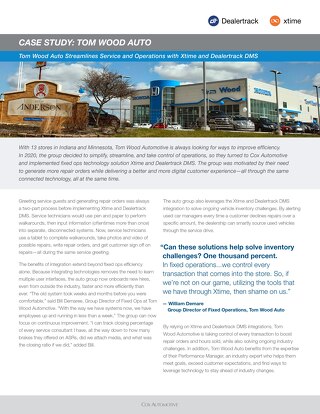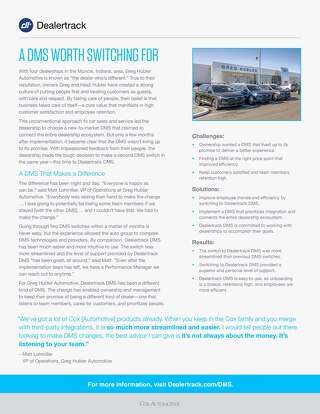Tom Wood Auto Streamlines Service and Operations with Xtime and Dealertrack DMS



Making the move to a new Dealer Management System requires careful consideration from the stakeholders at your dealership. When evaluating the technology that houses the data driving your business, your entire staff will be affected by making the switch. For the team at Greg Hubler Automotive, who made the switch to a new-to-market DMS in early 2022, the promise of a better experience for both their guests and their people was reason enough to leap into the unknown. However, when the promise from their vendor was under-delivered and their employee morale took a big hit, Matt Lohmiller, VP of Operations, was ready to pull the plug. Greg Hubler Automotive is a different kind of dealer—one who truly values its people and its guests. Here’s their story.
A few months after implementing their new DMS, Lohmiller received feedback from his team that things weren’t on the up and up. “I was going to potentially be losing some team members if we stayed (with the other DMS) …and I couldn’t have that.” Employee retention and satisfaction have always been key components of what makes Greg Hubler unique. While going through multiple DMS switches within several months isn’t ideal, Lohmiller took careful consideration from his team and decided to switch to Dealertrack DMS. After hearing their input, it was clear which direction they wanted to go. “We had to make the change,” he recalls.
A key benefit of making the switch to Dealertrack DMS was the ability to observe the implementation process first-hand and compare the difference from Greg Hubler’s previous provider. The switch to Dealertrack DMS was more streamlined and the level of support “has been great, all around,” said Lohmiller. “Even after the implementation team has left, we have a Performance Manager we can reach out to any time.”
For the people at Greg Hubler, the difference has been night and day. The change enabled ownership and management to keep their promise of being a different kind of dealer—one that listens to team members cares for customers and prioritizes people.


Changing technologies might be the right move for your dealership, but it’s never an easy decision. Many dealers hold off switching to a new Dealer Management System for fear of disrupting workflows and downtime. It’s not a decision that any dealer takes lightly, which is why it’s so important to find a DMS partner committed to helping you every step of the way. Watch this video and discover why making the move to a more flexible DMS was worth the switch for these real-world franchise auto groups.
Your DMS provider should be invested in your success. When it comes to the time for installation, your new DMS team should be on-site, ensuring that your dealership has everything it needs to succeed. That means answering your questions, ensuring that every employee is up to speed, and employing industry best practices for data migration and installation.
Once your installation is complete, your new DMS partner should help you get the most out of your new technology. Your provider should have an ongoing presence in your dealership, consulting with your teams on a regular basis to improve performance and help enact operational changes when necessary. Because technology and the auto sales industry are constantly changing, your DMS partner should be forward-thinking, providing ongoing support and updates to help your dealership grow, as the industry evolves.

Your dealership’s data is your business, literally. It’s the key to invaluable insights into your customers, your operation, and the overall performance of your dealership. When you’re in control of how you run your operation—and whom you choose to do business with—you not only save time, but you also save money. Find out why dealers like you are switching to a DMS partner with open and integrated solutions. Watch the video.
Are you spending money to access data you already own? It sounds wild, but certain vendors can and do charge (often hidden) fees just to access customer information. The average dealership now uses up to seven software systems to complete a sale—and that can add up over the course of a year. Most franchise dealers are paying up to $42,000 every year on integration fees, alone. * (Yowza.) A DMS partner who offers seamless integration with bi-directional data flow and third-party software and OEM integration, would speed up processes and save dealers a lot of cash.
How you access your data is just as important as how you share it. Your data should be on demand, not waiting for you the next day after a lengthy overnight download. Your DMS partner should empower you to access your data when you want, whenever you want. With unrestricted data access, you can get up-to-the-minute insight into transactions, account balances, and dealership performances. You have the freedom to make quick, effective decisions at a moment’s notice, with every possible piece of information.
It’s your data. You should be able to access it when, and where, you need it most.
References
*Avg. $500/month x 7 third-party apps x 12 months = $42,000/year

A good salesperson can earn your business. And, often, that business transaction ends at the point of sale. But a great partnership is built long after the ink dries on the contract. Your DMS partner should work hard to help you achieve success. Improving your day-to-day operations and accomplishing long-term goals is an investment in the future. You expect your technology to do a lot for your organization. It’s time to start expecting more from your partners. See why dealers like you are making the decision to switch to a partner invested in their success. Watch the video.
A great business partner should empower you to be the company you want to be. That means working with your team to ensure a seamless installation and technology migration. It means helping you find solutions to all your questions and working with your dealership to get the most out of your technology. Your DMS partner should be an invaluable resource to you, helping your team navigate industry complexities, enact operational change, and grow your business.
Any technology you take the time and resources to invest in should be intuitive to learn for new and experienced employees alike. It should make your operations more efficient by reducing the number of clicks to complete a task and making it easy to access information. That includes being flexible enough to integrate seamlessly with third-party systems and meet the requirements of every dealership department.
Finally, your business partners should be easy to do business with. Technology providers should earn your business every month, giving you the freedom to choose and the ability to change direction at any time. That means offering flexible contract terms, not auto-renew clauses. In other words, you should be in control of the direction of your dealership, not your DMS provider.

When the data in your dealership doesn’t sync with the technology you’ve invested in, your staff will almost certainly struggle. Don’t settle for manual processes and broken workflows that frustrate your customers and your employees. Rather, opt for connected technologies that deliver time-saving solutions that result in higher profitability. Watch the webinar.
The fact is today’s increasingly competitive franchise dealerships must create seamless experiences that win repeat business and add additional revenue. Fortunately, connecting your service technology and DMS helps maximize efficiency and revenue while strengthening your dealership with the power of continuous, real-time data.
When you combine the power of Dealertrack DMS and Xtime, you give your team the tools they need to successfully utilize and track discounts, including:
If you’re like most dealerships, your effective labor rate is probably not very good. By combining Dealertrack DMS and Xtime, you can separate mechanical repair (ML) and quick lane (QL) to:

Jade Mitchell
Jade is the Sr. Manager of Performance Management at Dealertrack DMS. He has more than two decades of experience working inside automotive dealerships. Today, he works with dealerships to maximize utilization and to drive process and profit improvement. He believes that deep-dive DMS data can have a sizable, measurable impact on dealership success.

Dreaming of investing in new technology to give your dealership that next-level boost over the competition? Many dealers get sold on fancy technology promises but lose sight of their goals and business needs in the process. Finding a new DMS partner is a big decision. But you can break it down into smaller, more manageable steps with the advice of Cox Automotive’s Director of Product Consulting, Josh Bickerton. Learn how to Invest in a Strategy to Overcome Inertia below and watch the full webinar to Demystify a DMS Switch when you’re ready.
Understanding your own dealership goes beyond the day-to-day workflows. If you’re not taking a close look at your mission statement and what sets you apart from the competition, you’re at risk of losing sight of your core values in the overwhelming decision-making process. Start here, otherwise, you’re at risk of letting technology own the decision you’re about to make.
Fear of change can derail even the best decisions. Make sure to stay aligned as a team by writing down how well a potential provider addresses your wants and needs. Catalog each department’s unique challenges to ensure you have a clear line of sight into the issues you hope to address by a technology switch
Don’t ignore the fact that a new DMS will impact your current and future team members. Millennials and Gen Z now make up a significant portion of your workforce. According to a
report from cloud networking firm, HPE Aruba, 93% of surveyed employees believed their workplace would be better if their employer made greater use of technology, and 64% believed their companies will be left behind if they didn’t implement new technology. *
The natural reaction to risk is to stick with the status quo. The ‘unknown’ can be perceived as threatening and switching to a new DMS can make even the most experienced employee feel like a novice again. Will your paycheck suffer? Will there be a negative impact on the business? Investing time and effort in learning a new system (or training new employees due to turnover) is also a common fear. Will my support staff assist with the change, and could we lose our data? It would be a mistake to ignore these very real, very common fears. Leaders and decision-makers need to address and acknowledge the anxiety that comes with any technology change.
Knowing that no software change will be a perfect fit is not only realistic; it is also the antidote to the fear of change. When your staff understands that there will be grace given for a learning period due to change, and expectations are managed, some of the anxiety will be released.
Have an agreement with your team that evaluating your new technology will be given a wholehearted effort. While many software companies may try to earn your business with shiny bells and whistles, you and your team will do your best to put in the discovery work and find a solution that meets your unique business needs.
Before you make the decision to switch (or put the fear of change on the table) take a good look at your DMS vendor contract to fully understand when your contract ends. If you have ongoing 3rd-party vendor agreements, be sure to evaluate those as well.
Making a DMS switch impacts your whole dealership. From the data you use to deliver premium customer experiences, to running payroll, your DMS is the backbone of your entire business operation. But finding the right partner can empower your franchise to profitability once you’ve made the move. While it may seem overwhelming, it doesn’t have to be. Watch the on-demand webinar, Demystifying a DMS Switch: 7 Key Principles for Success.
Source: https://betanews.com/2018/06/04/technology-improves-job-satisfaction/

Retail technology changes fast. As car shoppers continue to evolve their preferences, they increase their demands for dealerships to keep up. Despite the pace of change and the pressure from consumers, many dealers aren’t in a rush to refresh their old technologies—especially their Dealer Management System. After all, change is difficult and many dealership employees aren’t excited about having to learn new tools, systems, and processes.
Hanging onto old, outdated DMS platforms may be a common practice among dealerships, but it doesn’t make much business sense. When dealerships refuse to evolve, they lose ground to their competitors and they risk losing customers who expect a more modern, technology-assisted buying experience. And, with new, easy-to-learn technology tools, the cost of making a change has gone down drastically. Consider the following important impacts of implementing easy-to-learn technologies at your dealership.
Onboarding is an important process at every dealership, but the process of getting new employees up to speed can distract from revenue-generating activities. One recent study suggested that it can take up to eight months for fresh new hires to reach peak productivity. When your DMS is easy to use and easy to learn, your new hires get up to speed faster and more efficiently.
When your dealership runs on a difficult-to-learn DMS, it becomes necessary to hire employees based on their past DMS experience. In fact, candidates with prior DMS experience often edge out better candidates that don’t have a history with your difficult DMS platform. Unfortunately, eliminating impressive job candidates is not a good formula for customer satisfaction. When your DMS is easy to use and easy to learn, you can hire candidates that will fit your culture and care for your customers.
Develop Your Engaged Employees
In today’s job market, the very best employees aren’t just looking for a job. Instead, many young digital natives are looking to develop new skills while advancing their careers. To attract and retain them at your dealership, you’ll need to offer lots of opportunities for professional development. In fact, a surprising 87% of millennials listed professional development as even more important to their job search than time off and compensation. An easy-to-learn DMS offers endless opportunities for continued learning and a community they can turn to in order to develop new skills.
Technology change—especially DMS transitions—can be difficult, but holding on to old, outdated tools is harmful to customer experience and dealership profitability. An easy-to-learn DMS helps you hire better employees, onboard them more quickly, then keep them engaged with ongoing educational opportunities. Watch the video below to learn more about the business benefits of an easy-to-learn DMS.

The General Managers and Dealer Principals that I speak to are always brainstorming new ways to improve their business. And I mean always. It’s like they can’t turn it off. I’ve been in their shoes, too, with plenty of years as a General Manager, myself. I get it. In retail automotive, there’s simply no time to sit back and watch your business run, thinking, “Things are just fine the way they are.” When things are up—your competition down the street is doing better. When sales are down, maybe inventory is low, you focus on acquisitions and leads. And, always, you’re looking at data to run numbers from each department. When it comes down to it, running a dealership demands that all systems are working in sync.
I know for a fact that the right DMS technology can help your business thrive—earning you more money and helping your whole team to do their jobs more freely. When it comes down to it, the right DMS technology is a game-changer.
Your dealership deserves technology that doesn’t compromise when it comes to the important factors. Yet, a lot of the General Managers I meet are usually settling in several key areas when it comes down to it. They sacrifice on integrations, but they end up saving on cost. Or they find a great DMS that works with their CRM, but it’s cumbersome and doesn’t have flexible workflows. “Well, you can’t win them all,” is basically the sentiment. And that’s how it often goes. A truly versatile DMS should empower and improve the way your dealership performs by connecting your technology. Flexible integration with all of your dealership technology breaks down the silos that create cumbersome workflows and drive up fees from your providers.
When it comes to your technology provider, one major red flag is an insistence on signing lengthy contracts that ensure your partnership long into the future. You don’t know what the next two years will look like—just look at the last two! When a vendor no longer has a need to earn your trust every month, you’re in a bad position. Does your business have plans to expand? What happens when you outgrow your current provider? Whom do you contact when you discover you’re paying more than you expected due to costly integration fees? In one study, an average dealer could expect to spend $42,000 a year on integration fees.
More of the buying process has moved online. But the idea that buyers are forgoing any interaction with your sales team is sort of a misunderstanding. While it’s true that heavy digital users have reduced their time at the dealership by up to 40 minutes, in one report, they still visit. Some interactions will be 100% virtual. Others will take place in the showroom or the service center. Optimizing efficiency is key. And the way to do that is by streamlining your workflows, reducing the friction points your staff encounters when switching from disparate software systems that enable transactions and when pulling valuable data. When your team has access to technology that puts data right at their fingertips—and doesn’t slow them down—they thrive. And so do you. Your DMS technology shouldn’t take weeks and weeks to master. In fact, the sooner your team can reach productivity, the better they’ll feel about their roles.
It’s been quite a whirlwind year for dealers that I’ve talked to. Inventory levels have yet to recover. The sales process continues to move to a more digitized model. And service optimization is making it easier than ever to connect consumers and your service lane. Buyer satisfaction rates are up, year-over-year, to 72%. But bad habits are often formed in good times. And, without a partner in your corner, things like inflation, rising interest rates, and the cost of doing business are going to catch up.
About the Autho r | Randy Wilson
r | Randy Wilson
With over thirty years of experience in the retail automotive industry, Randy Wilson brings exceptional wisdom to his role as Director of Performance Management to the Dealertrack DMS team. By leading a team of Performance Managers who have all previously held high-level dealership responsibilities in their careers, he is committed to driving rapid transformation and building measurable growth for our partners. Randy joined Cox Automotive in 2012 and works tirelessly to bring real-world experience into the development of technologies that enhance the day-to-day performance and efficiencies of every aspect of the business. In his spare time, he can be found sporting his Cheesehead gear and spending any spare moment boating and fishing on the ocean. He and his wife have four children together and five grandkids.